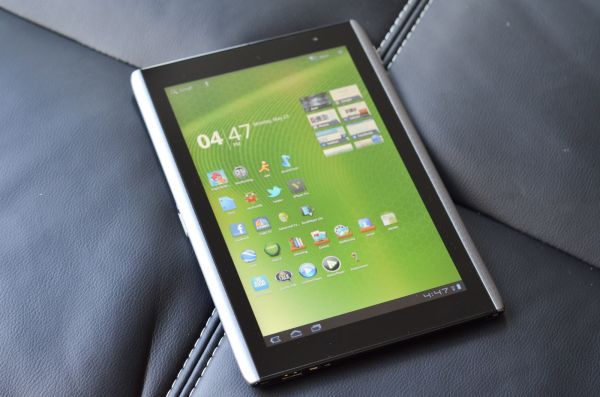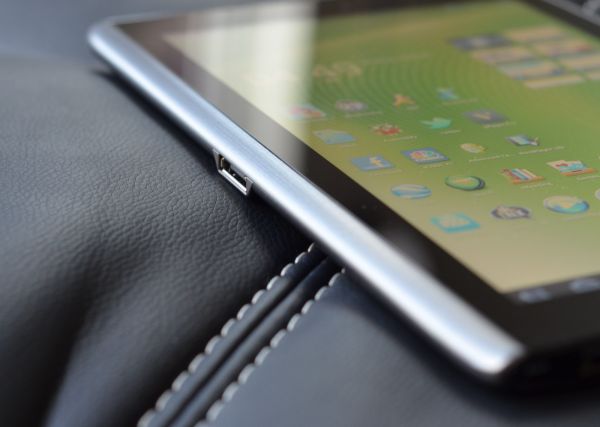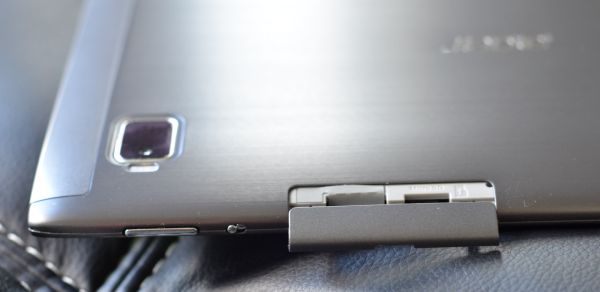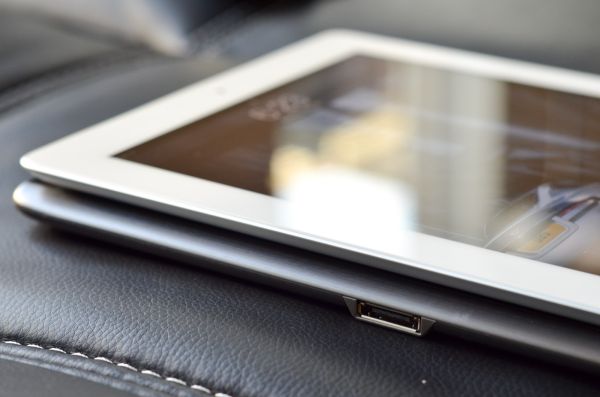Acer Iconia A500 - Honeycomb on a Budget
by Vivek Gowri & Jarred Walton on June 24, 2011 4:00 AM ESTNext in our series of Honeycomb tablet reviews is the Acer Iconia Tab A500. The A500 was the second Honeycomb tablet to go on sale, and is one of four on the market at present, all of which are very similar. They share basic specs—10.1” 1280x800 displays, NVIDIA’s Tegra 2 underhood, 1GB LPDDR2 RAM, 16-64GB onboard NAND, front and rear facing cameras with HD video capture, basic wireless connectivity options, and stock versions of Android 3.0/3.1 Honeycomb (albeit with different preloaded software packages). The hardware similarities makes things like design and price that much more important, and the latter is where Acer seemed to have an edge.
| 2011 Tablet Comparison | ||||||
| Apple iPad 2 |
Asus Eee Pad Transformer |
Motorola Xoom WiFi | Samsung Galaxy Tab 10.1 | Acer Iconia Tab A500 | ||
| SoC | Apple A5 (Dual ARM Cortex A9 @ 1GHz) | NVIDIA Tegra 2 (Dual ARM Cortex A9 @ 1GHz) | NVIDIA Tegra 2 (Dual ARM Cortex A9 @ 1GHz) | NVIDIA Tegra 2 (Dual ARM Cortex A9 @ 1GHz) | NVIDIA Tegra 2 (Dual ARM Cortex A9 @ 1GHz) | |
| GPU | PowerVR SGX 543MP2 | NVIDIA GeForce | NVIDIA GeForce | NVIDIA GeForce | NVIDIA GeForce | |
| RAM | 512MB | 1GB | 1GB | 1GB | 1GB | |
| Display | 1024 x 768 IPS | 1280 x 800 IPS | 1280 x 800 | 1280 x 800 PLS | 1280 x 800 | |
| NAND | 16GB | 16GB | 32GB | 16GB | 16GB | |
| Dimensions | 241.2mm x 185.7mm x 8.8mm | 271mm x 175mm x 12.95mm | 249.1mm x 167.8mm x 12.9mm | 256.6 x 172.9 x 8.6mm | 260 x 177 x 13.3mm | |
| Weight | 601g | 695g | 730g | 565g | 730g | |
| Price | $499 | $399 | $599 | $499 | $449 | |
Long a sales leader in the budget notebook market, Acer jumped into the tablet game with a price advantage—the Iconia A500 came in at $449, in comparison to $499 for the iPad and $599 for the WiFi-edition Motorola Xoom (though it is worth mentioning that the Xoom comes with twice as much onboard storage as the Iconia and iPad). ASUS released the $399 Eee Slate Transformer soon afterwards, but supply issues meant that the Acer was the cheapest readily available Honeycomb tablet for some time. More recently, some retailers have dropped the prices of the Iconia, with MacMall selling it on their eBay store at one point for just $379. On paper, that’s a screaming deal, but most of the time it sells for closer to its $449 MSRP. Outside of pricing, though, how does the Acer hold up in real life?
The Hardware
Since the software and internal components are so similar between devices, the price, design, and screen tend to be the largest differentiating factors, in that order. Alas, the A500’s design isn’t on the same level as Apple, or really anyone else. Of the four Honeycomb tablets right now, the Iconia probably has the weakest design.
Acer’s design team went with the metal-and-glass approach, with an aluminum chassis wrapped around the screen capped by black plastic on both sides. That’s a good way to go on paper—similar designs have been implemented by Apple, Nokia, and HTC to great success. The main benefit is that it allows for nearly seamless construction around the body, as seen in the iPod mini and iPod nano, as well as the Nokia N8 to a lesser extent (the N8 has a more complex design that necessitates some seams for the sloping end-pieces, but the main body has a similar wraparound style).
Unfortunately, Acer lost the plot a little by putting a seam down the top and bottom edges of the device. So much for a unibody construction. As a mechanical engineer, I understand the complexities of manufacturing the entire body as a single part, but it’s the kind of thing that makes a device feel like a premium product. There are some good things going for the Acer here—the design itself is attractive, and the brushed aluminum finish is great (I’d have personally preferred a lighter silver color rather than gunmetal, but still), and little details like the speaker grills look great. But by and large, I see areas where the hardware just doesn’t have the polish of the other big names.
There's minor flex and creaking in various parts of the chassis, large panel gaps (1mm), seams in places you don’t expect to find seams, the SD card door that feels like it might snap at any second, the screen not sitting flush with the aluminum bezel—these are all minor things, but that kind of attention to detail is necessary for any company that wants to seriously challenge Apple from a hardware perspective. Acer also has to contend with ASUS, given that ASUS is currently priced lower and comes with an IPS panel and better overall construction.
At 13.3mm thick, the A500 is definitely on the chubby side—it’s only a hair larger than the Transformer and the Xoom (both at 12.9mm) but significantly thicker than the sub-9mm iPad and Galaxy Tab 10.1. The Iconia is slightly narrower and taller than the Transformer, but both have a larger footprint than the Xoom and Galaxy Tab 10.1. The Iconia matches the Xoom at 730g (1.61lbs) and comes close to matching the 695g Transformer, but none of the Honeycomb tablets can come close to the Galaxy Tab 10.1’s positively anorexic 565g (1.25lb) figure.














45 Comments
View All Comments
VivekGowri - Friday, June 24, 2011 - link
Fair point, I'll stop saying that.TrackSmart - Monday, June 27, 2011 - link
I was walking by Staples today and saw lots of banners advertising tablets Motorola Xoom, Blackberry Playbook, and Acer Iconia 500 among them). I couldn't help but stop in for a hands-on test. At first glance, the Iconia looked nice, but in the hand the Xoom sitting right next to it felt like a much more premium device. The Iconia was priced at $450. The Xoom at $600. So I guess that's what 1/3 higher price buys you. The Iconia was less sleek and had flex to it that nearby Xoom didn't show any signs of.My main impression is that these 10" tablets are much larger than I'd like them to be. The 7" playbook felt like a better size. If they could have kept the 7" screen size on the Playbook, but shrunk the huge bezel by 75%, it would have been portable enough for day-to-day usage as an internet portal and as an ereader. And if they then dropped the price down to about $300 (netbook prices), I might even be tempted to buy one.
For now, they hold limited appeal (for me personally) due to large size and high prices relative to what you get in terms of performance and functionality. Maybe the next generation will get there.
TrackSmart - Monday, June 27, 2011 - link
Looking at my post, I can see why the Nook Color is doing so well. It's priced right and still feels like a fairly premium device despite that low price.MrMilli - Friday, June 24, 2011 - link
quote: "The GeForce ULP used in Tegra 2 packs the same number of shaders (eight) as the old GeForce 8100, but they’re running at 300MHz (compared to 1200MHz on the 8100); that means it has about 25% of the horsepower of the old 8100 IGP, ..."Let's not forget that the Geforce ULP is a Geforce 6000 generation GPU. That means 4 pixel and 4 vertex shaders. I would say that it doesn't even have 15% of the horsepower of the old 8100 IGP.
radium69 - Friday, June 24, 2011 - link
QUOTE:"What I really need for tablets to be useful is a killer app. I don’t carry around a clipboard ever, so they can’t fill that role. If I need to type an email or do any real work, a keyboard is generally a requirement. For everything that a tablet can do, a decent smartphone is similar and it can fit in your pocket. So on the one hand, I love having a larger 1280x800 display that I can actually use to browse the web, but on the other hand I just can fit something like that into my current lifestyle. The most use I got out of the A500, outside of testing, was on Sundays when I took it to church. I was able to replace several bulky items (scriptures and lesson manual) with a single device that easily fits in a briefcase, and it was easier to use than a notebook. I could still do the same thing on a smartphone or iPod Touch, but reading books/manuals on the iPod isn’t very easy on the old eyes. I would assume that students could benefit from a tablet in a similar manner, provided they can get all of their books and other materials in digital format. Carrying a <2 lbs. tablet around campus in place of three heavy textbooks sounds like a great idea, but I’m not sure about note taking and I always had a soft spot for scribbling in the margins—plus I know a lot of engineering courses have open book exams, and I doubt they’d allow a tablet to qualify as a “book”."
This is what I think it's saying:
A tablet doesn't excel in anything except portability. It might be usefull for students but not more.
I think, you have covered it all. A tablet is just a "Tablet" might be fun for gimmicky sales and might bring laptop prices down. But they never can compare to a netbook or a decent notebook. And with the grow of smartphones all around I think we are looking at better battery life in our phones. So basically, all ground is covered with a net/notebook or phone.
It all adds up to the equation...
Productivity on a tablet is close to 0% anyway.
I hope they be gone soon and focus more on phone progress and laptop progress.
FrederickL - Friday, June 24, 2011 - link
Yes, to a considerable extent they still are. However the author has mentioned the upcoming developments in hardware and I believe that the signs are that those developments are accelerating. In a year to eighteen months we are likely to be seeing a whole new generation of *much* more powerful tablets (both 7 and 10 inch form-factor) with much longer battery-life. If the rumours are to be believed we may even begin to see Win8 devices as early as Q4 2012. Combine that with a charging/extra ports docking station and a full song with choruses fully functional os that functions the same as on any work-station or laptop (*if* MS actually succeed in implementing what they say they are aiming for) then, and IMHO only then, we will have devices that will have a similar effect on the laptop market that the laptop has had on the stationary pc market. I imagine a 7 inch form-factor with a docking station in my tv-bench. When I put it in the dock it boots the conventional GUI to the TV and I can interact with it by means of mouse/keyboard from the comfort of my armchair. When I take it from the dock it switches automatically to the touch UI and I slip it into the inside pocket of my jacket knowing that I have something to read on the bus. At work it goes into a second dock etc. If I am travelling I take a small media keyboard with my tab if I know that I have a lot of writing/data entry to do. Such a device would replace my living room pc, my laptop and my Kindle. Now *that* would be a productive device!
oliwek - Monday, July 4, 2011 - link
"And with the grow of smartphones all around I think we are looking at better battery life in our phones"really? come on, android phones with heavy use do not last a full day without charging. ASUS Transformer tablet with dock on the contrary stays ON for 16 hours (9 hours for the tablet alone).
darkhawk1980 - Friday, June 24, 2011 - link
I came to most of the same conclusions myself, before I bought my Asus Transformer.The Iconia, while it has a few nice features (ie screen is one of the better LCD's, built in USB and microSD), it's not enough to make it a worthwhile buy while a tablet like the Transformer exists. At $350, it's a great buy. At $400, it's maybe worth it if you like the included USB. At $450, it's over priced and not worth it at all.
Lastly, concerning the 'usefulness' of tablets, it really depends. I don't want to lug around even a 2 lb netbook to work and back (I carpool about 35 to 40 minutes 1 way to work), and my company doesn't allow personal computers in the building (tablets are not defined as computers where I work, as stupid as it sounds). That being said, a tablet works very well for me. I also get ALOT more use of it at home now while watching TV, and even taking photos and videos of my son with it. It is bulky and clunky for photos/videos, but I make do and I enjoy it very much. While productivity isn't the main reason for my purchase, I can see where this would have it's uses. I think the biggest problem is the lack of a good annotating application (similar to Iannotate for iOS) on Android. If one did exist, it would really benefit Android as a whole in the schooling market.
haplo602 - Friday, June 24, 2011 - link
I think Jarred nailed it :-) The tablet is a portable document reader, nothing more. Basicaly I can find a single use for it. When I travel and don't want to carry a laptop. These are usualy short and light trips. Use for web, email, ebook, movies and simple games.Paired with a stupid mobile (like my SE C510) for tethered connectivity.
Belard - Friday, June 24, 2011 - link
Same as before... man, you guys are sometimes too 'techie".Not a creation device, but a playback device. Yes, my iPad is weak compared to my dual-core ThinkPad or my QuadCore Desktop with a 24" screen. But try relaxing in bed or the sofa with a notebook or desktop computer. Be cozy with those devices... not going to happen.
How about boot up time? These tablets are instant on... vs. 1-2 minutes for a typical notebook or desktop. (I put my notebook in sleep mode half the time, restart time is still about 6~10 seconds).
Try reading an ebook from your notebook to you kid(s)... especially while the cuddle next to you.
Theres a reason we have desktops and notebooks... and a tablet is no different. Its designed to function for its form-factor. High-end gaming, I'm not really seeing it... gotta have REAL buttons and twisting-tilting your screen for a steering wheel sucks. Steer buttons on the side of the screen would be better. There is a REASON a $120~180 Nintendo DS or PSP make good game platforms, but not good e-readers or browsers.
Why do we have more than 2-3 times of glasses and cups? Why have a saucer when a plate will do? Anyone with a knife-block with 6~20 types of cutting tools?
- - - -
Productivity on a tablet can vary, depending on your needs. I've only bought my first notebook 3 years ago because I had a need for a portable computer, but for the most part - its first year was very light usage.
In about a 14 months, Apple has sold 25 million ipads (10 million iPad2 in 2 months)... they are not going anywhere.
Funny thou, in the movie 2001, the astronauts in Discovery are using a tablet that is as thin as the iPad2 (if not thinner) and about the same size. Not bad for a movie from 1968... then in the movie 2010, they used an AppleII as a notebook... that is HUGE. :)